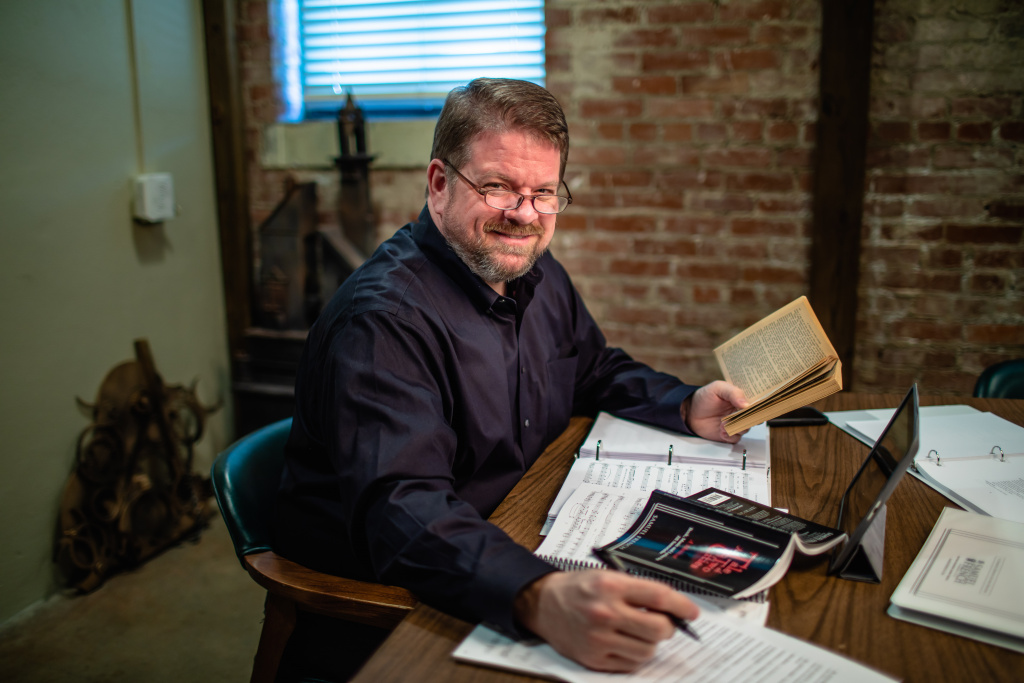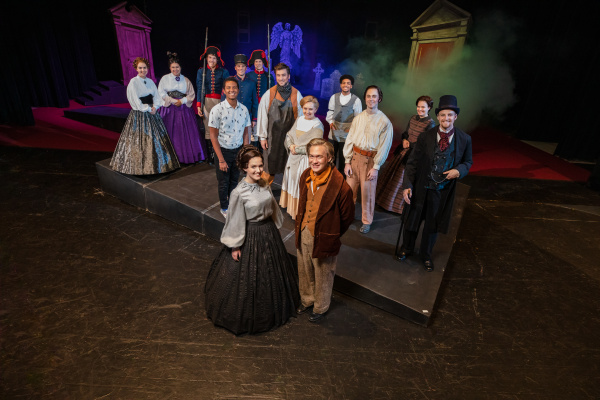In 2016, BJU produced its first musical. Little Women was an instant hit. The University is still humming with the success of its second musical production, Titanic, which won Best Musical (non-professional) in the 2019 BroadwayWorld South Carolina Awards.
In October 2019, Dr. Darren Lawson, dean of the School of Fine Arts and Communication, announced that A Tale of Two Cities will be the third musical performed at Rodeheaver Auditorium. This show is based on the novel by Charles Dickens with words and lyrics by Jill Santoriello.
See Also: The Best and the Worst of Times in Writing a Musical
So, what does it take to put on a musical at BJU? Lawson shared the steps he takes to develop a production, from choosing the show to opening the curtain.
Step 1: Select a Musical
Before Lawson can choose a musical, he must know what is available. “I start with benchmarking as much as I can so I know what’s out there. … And I try to get my folks out to see other productions so that we see what’s current,” he said. Before producing Little Women, Lawson made sure to see it on Broadway and again when the show was on tour. “Sometimes they’re different, and so I like to see those (differences),” he said. Playbills for possible future musicals are in a folder in the fine arts department.
Sometimes, a show is so good, it inspires more than just the collection of its playbill. Lawson said, “If I really like (a show) then I’ll right away purchase a score if I can. … So, when I saw A Tale of Two Cities in 2008, … I purchased the score, and I’ve been sitting on that for a number of years.”
The theme of the musical has also unintentionally come to play a role in Lawson’s selection process. “We started with Little Women, which is a wonderful piece of literature,” he said. “And then we did Titanic, which has historical significance, and then I (realized) the first two have been ones that really are in line with our liberal arts focus here. … I was picking musicals that have to do with great literature or some historical event. And then, of course, next year we’re doing Dickens’ A Tale of Two Cities. I don’t know how far we’ll be able to stick with that, but that has kind of been (the trend). … We’re getting to experience Little Women the story, and we learned about Titanic last year, and I think that’s good for our students. It’s contributing to the history that they’re studying here. It’s contributing to the literature that they’re studying. I would like to say I planned it, but it was purely accidental.”
Lawson also verifies that any musical considered for production at BJU aligns with the University’s standards. For example, while the well-loved musical Les Misérables tells a beautiful story of redemption, it also contains a couple of scenes that clash with University standards. “Historically, that probably was an accurate portrayal of how things were,” Lawson said. “They’ve accurately and honestly portrayed that on stage.” While acknowledging Les Mis would be “beautiful on Rodeheaver stage,” Lawson said, “You can’t just cut the scenes because they’re integral to the story. … I want to pick pieces that are not going to cause people to stumble, so that’s an important part of my process.”
Step 2: Choose the designers
After a musical is chosen, Lawson will select the production’s set and costume designers. He works with Dr. Lonnie Polson to evaluate the theatre faculty’s load to determine who has the most availability. “Generally, I look and say, who’s my best person? (For A Tale of Two Cities), Jeff Stegall is the person that I want coordinating with the (costume) rental houses to say, here’s what we need,” Lawson said. Stegall was also the set designer for the production of Titanic.
See Also: Setting an Unsinkable Stage
Step 3: Create a character plot
Next, Lawson sits down with the script and draws a grid with the characters down the side and the scenes across the top. If a character appears in a scene, a code goes into the appropriate box. Lawson has specific letter codes for when a character has a solo, appears in the chorus, has speaking lines and is a walk-on. Once he has filled in the grid for every character and every scene, he is able to glance across the character plot and see which roles he might be able to double cast. “(A character plot) gets it objectively on paper in front of me. I do a lot of analysis ahead of time. … But I like that. I like the creative and organizational, logistical things as well,” he said.
Step 4: Hold auditions
With a completed character plot, Lawson knows who his main characters are and what type of voices he needs, and he’s ready to hold auditions. The first stage of auditions is held in New York City, where Lawson searches for guest artists. The second round is held on campus for anyone who would like to participate.
“Sometimes I get criticized for not making it an all-student cast,” Lawson said. “If we went that direction, it would fundamentally alter the literature that we do. We couldn’t do Aida. We couldn’t do Lucia di Lammermoor because 18–22-year-old voices are not developed well enough. So, it could be done, but we would have to choose different literature.” Instead, Lawson has elected to cast musicals and operas with professional guest artists in addition to faculty, staff and students.
“This has worked really well, and I think our students really enjoy working alongside professionals in the industry,” he said. “(Guests like) Patrick (Dunn) and Caitlin (Mesiano), they’re so much fun, and they kid with the students, and they have lunch with the students, and (the students) get to see their work ethic up on stage. To me, that’s part of an educational process that they wouldn’t get if they were just doing it themselves.”
In early December, Lawson’s office sends a memo to agencies in NYC informing them that he will be holding auditions in January. In New York, Lawson said, “I pretty much block out an afternoon at one of the audition halls up there. Every seven minutes, I see a new singer.”
Some performers know Lawson’s and BJU’s reputation and are eager to audition for a guest artist role in the University’s productions. Mesiano, who won Best Actress in a Musical or Play (non-professional) in the BroadwayWorld South Carolina Awards for her role in Titanic, and Dunn, currently playing Jean Valjean in the touring production of Les Misérables, are among that group. Both performed in BJU’s first two musicals.
To Mesiano, Lawson’s attentiveness and friendliness during auditions made the greatest impact. “From the moment I first met and auditioned for Darren, I felt welcomed, appreciated and respected,” Mesiano said. “This business is hard. Oftentimes, we pour our heart and souls into an audition or preparing for a role, only to have the person sitting behind the table to be on their phone or computer while you’re sharing your hard work. Sometimes, they never even see 90% of what you prepared for them. But when I first auditioned for Little Women — a show very close to my heart — I immediately felt this experience was going to be different. Darren welcomed me as if we’d known each other for years, and I immediately felt the confidence and courage to actually open my heart to this character for him. And what do you know? It worked.
“Darren cares so much about his work on a deeper level than most, so naturally people want to do their best for him. This is so clear in his work with his students, his co-workers and the guest artists alike. I am forever grateful he gave me the chance to shine in a way I never had before.”
Dunn’s experience in the BJU musicals has rivaled the Broadway productions in which he has performed. “I’d have to say that accepting my first guest artist residency at BJU was exciting, to say the least,” he said. “Knowing that I was brought in to be an example for the students and to proudly be a piece in Dr. Lawson’s production puzzle of Little Women was a great honor and responsibility.
“What I didn’t realize was that I was doing another professional ‘gig.’ The difference between working with Darren and the students at BJU and working on Broadway and national touring productions is almost nil. The talent, orchestra, production value and creative team assembled by Dr. Lawson bring out the best in everyone, guest artists included. To be asked back to participate in Titanic was a true honor. Dr. Lawson’s direction on such a massive undertaking was smooth sailing for all involved.”
See Also: Guest Artists Applaud BJU Professionalism
After guest artists are contracted, Lawson is ready for campus auditions in April. Anyone who would like to be a part of the production may audition. For instance, the cast for Titanic saw faculty, staff and students studying music, cinema, theatre and Bible — among other programs — playing key roles alongside the professional performers. Auditions are open “to anybody and everybody,” Lawson said.
Step 5: Rehearse
Once voices are matched with the parts, work on the production expands from a select few to full-blown cast and crew. “We begin the rehearsal process with a table reading in September, continue with music rehearsals on Monday nights through first semester, and then start staging rehearsals in January, which run until the performance in March,” Lawson said. The closer to opening performance, the more Rodeheaver Auditorium buzzes with anticipation of the show.
Step 6: Break a leg!
When rehearsals are finished, choreography is learned, lines are memorized, costumes are fitted and makeup is done, it’s showtime.
Overall, producing a musical takes a little over a year. And it’s not as easy as Disney makes it seem. When blocking a straight play, Lawson said, you have to consider matching lines with stage directions. Opera is more complicated because you have to match music with stage direction. Musicals? “Musicals are, I think, the most complicated productions to direct,” Lawson said. Not only do you have to match stage directions with lines and music, you also have to add choreography and intricate stage business.
“I’ve been involved in all three, and I can say musical theater is definitely the most complex in terms of getting it up on stage,” Lawson added. “But it’s probably the most fun, too.”








